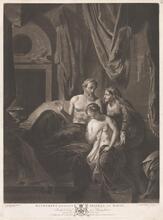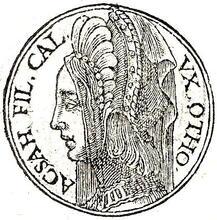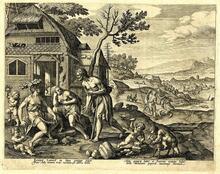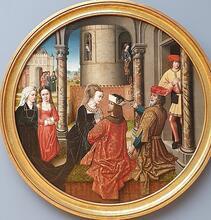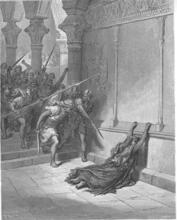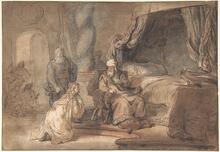Shunammite: Midrash and Aggadah
The Shunammite woman is celebrated by the Rabbis for her generosity and righteousness. The story of her hospitality towards Elisha portrays these traits, but the midrash also celebrates her for cautiousness, as shown by the narrative of her son. Even in her death, the Shunammite woman is used as a representation of purity, although individual midrashim analyze the narrative of the Shunammite woman’s corpse in slightly different ways.
Descriptions of the Shunammite’s Personality
One midrashic approach identifies the Shunammite woman who hosted the prophet Elisha as the sister of Abishag the Shunammite, possibly because of the “Shunammite” appellation they share (Pirkei de-Rabbi Eliezer [ed. Higger], chap. 32).
The Rabbis praise the hospitality of the Shunammite woman and learn from her conduct that everyone should bring a Torah she-bi-khetav: Lit. "the written Torah." The Bible; the Pentateuch; Tanakh (the Pentateuch, Prophets and Hagiographia)Torah scholar into their house, give him food and drink, and let him enjoy all that they possess (Perek Zedakot 1, in Ozar ha-Midrashim [Eisenstein], p. 499). The Shunammite woman is mentioned by the A type of non-halakhic literary activitiy of the Rabbis for interpreting non-legal material according to special principles of interpretation (hermeneutical rules).midrash as one of the twenty-three truly upright and righteous women who came forth from Israel (Midrash Tadshe, Ozar ha-Midrashim [Eisenstein], p. 474). Verse 20 of the “Woman of Valor” paean (Prov. 31): “She gives generously to the poor; her hands are stretched out to the needy” is applied to her, for having fed the prophet Elisha; as is v. 28: “Her children declare her happy,” because Elisha’s prophecy that she would have a son was fulfilled for her (Midrash Eshet Hayil, Batei Midrashot, vol. 2).
Speaking of the hospitality extended to Elisha, the midrash relates that the prophet would go from one mountain to another, and from one cave to another. When he came to the city of Shunem, the Shunammite woman received him with all honor (Pirkei de-Rabbi Eliezer, chap. 32). She told her husband (II Kings 4:9): “I am sure it is a holy man of God who comes this way regularly.” The Rabbis ask how she knew that Elisha was a holy man and reply that the woman saw that Elisha did not look at her, and whoever guards himself as regards married women is called “holy” (Lev. Rabbah 24:6). This midrashic scene may hint at the beauty of the Shunammite woman and that Elisha took especial care not to gaze upon her.
When the woman saw that Elisha had come back to Shunem, she suggested to her husband (v. 10): “Let us make a small enclosed upper chamber [aliyat kir ketanah] and place a bed, a table, a chair, and a lampstead there for him, so that he can stop there whenever he comes to us.” According to the midrash, this act by the Shunammite woman is mentioned in the prayer of King Hezekiah. When the latter realizes that he is about to die, he prays, as is related in Isa. 38:2: “Thereupon Hezekiah turned his face to the wall and prayed to the Lord.” In the Rabbinic interpretation, the “wall” [kir] was not the place where Hezekiah prayed, but the subject of his prayer. He said to God: “You restored to life the son of the Shunammite woman because she made an aliyat kir ketanah for Elisha. Will You not keep me alive, for my grandfather covered the entire Temple with silver and gold?” The king’s prayer was accepted, and God added fifteen years to his life (BT Berakhot 10b).
When Elisha saw all the bounty that the Shunammite woman had showered on him, he wanted to recompense her; therefore he summoned her, as II Kings 4:15 portrays: “He called her, and she stood in the doorway.” Why did she stand there? The midrash answers that no woman could gaze upon the countenance of the prophet Elisha son of Shaphat, for fear lest she die.
Elisha informed her that she would bear a son, to which she replied that her husband was very old and that she had ceased to be after the manner of women (v. 16): “Please, my lord, man of God, do not delude your maidservant” (Pirkei de-Rabbi Eliezer loc. cit.). She also told him: When the angels informed Sarah that she would give birth to a son, they said to her: “I will return to you at the time that life is due, and Sarah shall have a son” (Gen. 18:14), while you told me: “At this season, at the time that life is due, you will be embracing a son” (v. 16). Why do you not promise me that you will return to me when the time is due, as the angels promised Sarah? Elisha replied: Those angels knew that they live and exist forever, and therefore they promised to return. But I am flesh and blood, today existing and tomorrow dead. Therefore, I give you these tidings in this language, for they will come to pass whether I live or die (Gen. Rabbah 53:2).
In this midrashic tableau the Shunammite is portrayed as a careful woman who gives voice to her apprehensions. The prophet’s promise exceeds the bounds of Nature, and such a miracle had not occurred since the time of Abraham and Sarah. The Shunammite woman tries to hold onto something concrete and not build any false hopes, since she knows how profoundly disappointed she might be.
The Shunammite’s Son
God fulfills Elisha’s wishes and gives the Shunammite woman a son; as the Psalmist puts this (Ps. 145:19): “He fulfills the wishes of those who fear Him” (Pirkei de-Rabbi Eliezer loc. cit.). The Rabbis learned from the deeds of Sarah and the Shunammite woman that the commendable act of hospitality is rewarded by the birth of sons (Tanhuma [ed. Buber], Ki Teze 2).
When the child became older, he went out to watch the harvesters as a recreation, but tragically, an accident befell him and he died. The Shunammite woman went to Mount Carmel and fell before Elisha, with her face to the ground. She spoke to him, saying (v. 28): “Did I ask my lord for a son? Didn’t I say: ‘Don’t mislead me’?” In the midrashic elaboration, she employed a metaphor when speaking to the prophet. She said: The vessel was empty, and now it has been filled and spilled out (Pirkei de-Rabbi Eliezer loc. cit.). This metaphor compares two empty vessels: one was empty at first, while the second was full, but all its contents spilled out, thereby alluding to the woman’s situation. When she was childless, she felt like an empty vessel. Now, too, she is in the same situation, but her feeling of lack is more difficult once she has been filled and then emptied. Her loss at the death of her son returns her to her former condition, which is now much worse.
The Book of Kings tells that when the Shunammite woman came to the man of God “she clasped his feet. Gehazi stepped forward to push her away [le-hodfah]” (v. 27). The midrash understands “le-hodfah” as an abbreviation of two words: hod she-be-yofiyah, the “majesty of her beauty,” and learns from this that when Gehazi went to rebuff the Shunammite woman, he pushed the majesty of her beauty, that is, between her breasts. The Rabbis observe that although Elisha was extremely careful in sexual matters, Gehazi acted differently. Although the latter was a man of great Torah scholarship, he had three shortcomings: he was envious, for he desired Naaman’s money; he engaged in licentious behavior, for he pushed the Shunammite woman between her breasts; and he did not believe in the resurrection of the dead (see below) (JT Sanhedrin 10:2, 29b).
Elisha took his staff and instructed Gehazi: Go and place the staff on the face of the boy, that he may live, but say nothing on the way. Gehazi thought that Elisha was sporting with him, and he did not do as the prophet had told him. On his own initiative, Gehazi turned to everyone he met along the way and asked them: “Do you believe that this staff can resurrect the dead?” (Pirkei de-Rabbi Eliezer loc. cit.). According to another tradition, when someone met him on the way and asked him: “From where [has Gehazi come] and to where is Gehazi [going]?” he would reply: “I am going to resurrect the dead!”
Consequently, when he came to the son of the Shunammite woman, his efforts were for naught. Elisha told him: “It is not you who revive the dead, but God, of whom it is said [I Sam. 2:6]: ‘The Lord deals death and gives life, casts down into Sheol and raises up’” (JT Sanhedrin 10:2, 29b). Elisha stood on his feet and walked, placed his mouth on (the boy’s) mouth and his eyes on (the boy’s) eyes, and began to pray to God: “Master of all the worlds! Just as you performed miracles by my master Elijah and revived the dead, so, too, revive this child.” And the Holy One, blessed be He, granted his request (Pirkei de-Rabbi Eliezer loc. cit.).
In one midrashic account, the son of the Shunammite woman comes back to life twice, once when he dies in the field and Elisha revives him, as is related above; and a second time, after the death of Elisha. Her son is the “man” mentioned in II Kings 13:20–21 who came in contact with Elisha’s bones and came to life. Because of his own shortcomings he immediately died again and was reinterred elsewhere (Midrash Tehilim, on Ps. 26, para. 7).
The late Midrash uses the narrative of the Shunammite woman to depict the resurrection of the dead at the time of the Messiah. Just as her son came to life, ate and drank and took a wife, so, too, will it be with all the dead who will come back to life at that time (Tehiyat ha-Metim, in Ozar ha-Midrashim [Eisenstein], p. 578).
Midrashic Analysis
The episode of the Shunammite woman teaches that the charitable giving of food advances the resurrection of the dead, for “she urged him to have a meal” (II Kings 4:8) and thereby merited the resurrection of her son (Cant. Rabbah 2:5:3).
The Rabbis relate in a playful manner to the story of the son of the Shunammite woman, in order to derive the laws relating to corpse impurity. According to these laws, the corpse itself is not impure, but imparts impurity to any person or object that comes in contact with it. Thus, when the son of the Shunammite woman died, his body itself was not impure, but whoever came in contact with it would be so for seven days. When he came to life, he was pure, but when everyone touched him, to see if he were alive, they imparted impurity to him, because they had contracted corpse impurity from him. This is the meaning of the saying: “What renders you unclean does not render me unclean, but you have rendered me unclean.”
The son tells those around him, “What renders you unclean”—I, who imparted impurity to you with the impurity of my corpse, “does not render me unclean”—I did not impart impurity to myself, for I, myself, was pure; “but you have rendered me unclean”—while you imparted impurity to me after I came to life, for you had contracted corpse impurity and you touched me (Sifrei Zuta 19:11). Another tradition, however, insists that the entire discussion of the corpse impurity caused by the son of the Shunammite woman is based on ignorance: a corpse imparts impurity, and a living person does not (BT Menstruation; the menstruant woman; ritual status of the menstruant woman.Niddah 70b).
Amit, Yairah. “The Shunammite, the Shulamite and the professor between Midrash and Midrash.” Journal for the Study of the Old Testament 25, no. 93 (2001): 77-91.


